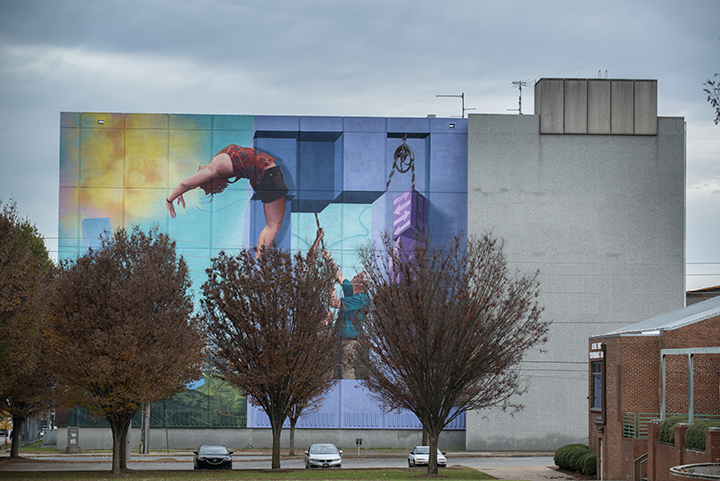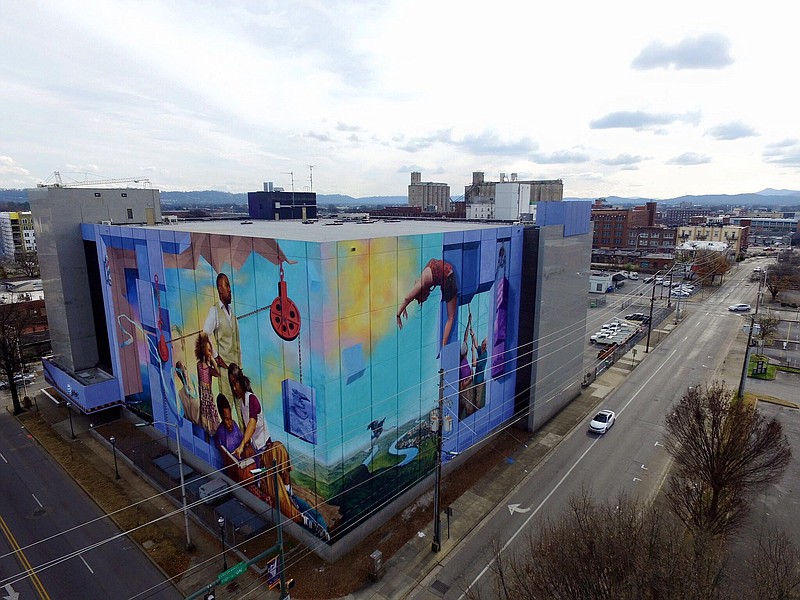 The M.L. King Mural, seen here from Houston Street, is a tribute to the rich culture of the black community long anchored on M.L. King Boulevard. A team of 11 artists, led by Meg Saligman created the mural on four sides of the AT&T building. Some 565 citizens helped paint the mural's portraits on a special fabric in a paint-by-numbers fashion. The fabric was adhered to the mural later with acrylic gel and blended into the surrounding images.
The M.L. King Mural, seen here from Houston Street, is a tribute to the rich culture of the black community long anchored on M.L. King Boulevard. A team of 11 artists, led by Meg Saligman created the mural on four sides of the AT&T building. Some 565 citizens helped paint the mural's portraits on a special fabric in a paint-by-numbers fashion. The fabric was adhered to the mural later with acrylic gel and blended into the surrounding images.If you go
The M.L. King Mural dedication will take place at noon Monday on the Bessie Smith lawn, followed by a presentation inside by Meg Saligman at 1 p.m. on the making of the mural.
Over recent decades, an estimated 900 urban streets in cities across the nation were rechristened to honor Dr. Martin Luther King's visionary civil rights legacy. Yet ironically, most of these corridors have suffered long stagnation. The Martin Luther King Boulevard that bisects this southern river city's heart is a sore example.
Even as Chattanooga's celebrated downtown revival has gathered force, the demise of its Martin Luther King Boulevard, renamed in 1981, is nakedly apparent. Vacant lots and desiccated buildings have steadily erased its once solidly segregated and richly exuberant character.
Still, there is fresh hope here for a new sense of dignity and respect for the African-American heritage ingrained in this once proud gateway. It is boosting emerging music venues, new businesses and eateries on the street, raising prospects for revival of its cultural history, if not its former prosperity.
The catalyst is a stunning new 40,000-square-foot mural which entirely cloaks a gloomy, windowless, 115-foot-tall, concrete-slabbed building - an ugly fortress that for 42 years has occupied the former site of the black community's popular old Liberty Theatre at the heart of M.L. King Boulevard.
The mural, commissioned under Chattanooga's Public Art program, gracefully transforms the building by portraying the boulevard's long-flowing history of work and family, hardship and radiately deep culture, in the African-American community. Indeed, its reach is transcending, changing the atmosphere and bringing new life to the history of the black community's culture in ways whimsical, inspiring and historically fitting.
Dancing on the top half of the east wall is Bessie Smith, a child of Martin Luther King Boulevard - formerly Ninth Street - who grew up to become the nation's famous "Empress of the Blues" in the 1930s.
Around the walls, a sometimes frayed rope links the transition of workers in the field, the fortune of good times, the city's scenic natural beauty, and the winding Tennessee River canyon that sustained Native American villages and later spawned their Trail of Tears. These are the bonds that bound white immigrants, blacks and Cherokees in intermingled lives.
These themes of lives across time inspired the work of the Philadelphia-based mural master, Meg Saligman, who won the city's commission for the art. Her work is rooted in the concept of relevance to the street where it stands, to the culture of African-American life from slavery to emancipation, and to the jarring journey of meaningful civil rights and belonging across the national landscape.
Before Saligman and her nine-member team began the six-month work, she and city stakeholders fully engaged the community through public meetings, then invited residents to "paint-day" sessions to help paint table-sized canvases used in the mural.
Saligman says she found the huge scale of the mural seductive, and the transformation of the segregated street's glory days more so. "People get it," she says. "It's the history of the community, the people in it. It's all deeply meaningful."
"I don't know of another project that so clearly represents the beauty of the street's heritage at a time when the street is so threatened," she says. "This is the most dramatic transformation of a site that we have ever done."
City Councilman Moses Freeman agrees. The monumental art has now become a redeeming counterpoint to the decline of Martin Luther King Boulevard here. Thanks to AT&T's more progressive management, which permitted the building's new skin, Freeman now describes the building's inviting mural as "the star of the street."
It acts as a "new meeting point," he explains. "It's going to draw economic development. I see people coming from all over to see it. It's replete with the history of the street, the business district, the culture, the diversity, the dignity we felt there. It represents us as a people. It's our place."
The elder city councilman rests his vision partly on the past, but with an eye to the future and growing diversity. He vividly recalls the street's once-crowded downtown stores, businesses, and cultural life - all concentrated in separate streets due to segregation. That division created a space almost exclusively for the black community. Music, restaurants, drug stores, and theaters thrived, and children were safe there at all hours.
The downtown street's decline began when the post-World War II economy and the civil rights era took hold. Whites headed for suburbia, blacks moved to neighborhoods that were left behind, and businesses followed their customers. The toll on Martin Luther King Boulevard was dreadful, and it had little white support to stem its fall.
Now, renewed appeal of urban life is drawing suburban residents back downtown, spurring gentrification, higher housing costs, renewed growth of small retail and service jobs - but still squeezing investments and pocketbooks of less affluent blacks. Encroachment by large development at each end of the street seems inevitable.
The clouded future of Chattanooga's civil rights memorial boulevard has prompted several local foundations to help promote renewed civic interest, new businesses and community activities on the boulevard. Their interest and financing, and the sweep of the mural, will at least help preserve the history of the city's Martin Luther King Boulevard. It may also inspire similar efforts in other cities facing the same dilemma.
If it does, that would be a boon to the nation's racial heritage, and an admiral measure of civic progress. If it requires monumental art, so much the better.
Harry Austin is a former editorial page editor of The Chattanooga Times and a native of Chattanooga.
